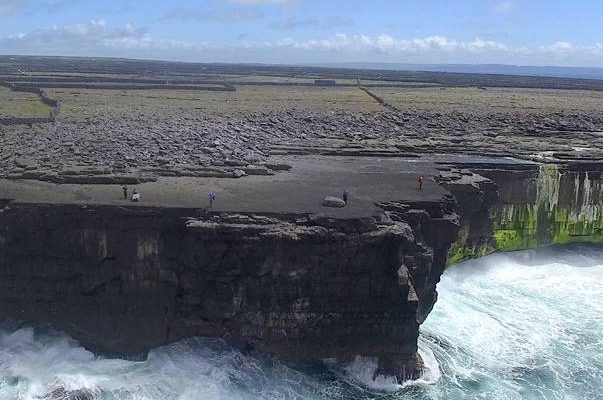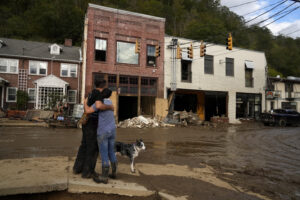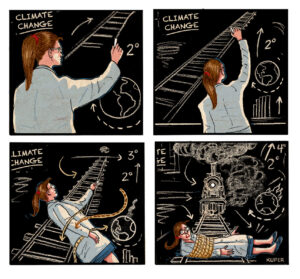Rising Sea Levels Come at Steeper Cost
As the oceans rise, so does storm damage to coasts and coastal cities: A recent study of South Carolina warns that financial losses caused by hurricanes could increase by 70 percent by 2100. Cliff-top boulders on Ireland’s Aran Islands, moved inland by recent storms. (Peter Cox)
Cliff-top boulders on Ireland’s Aran Islands, moved inland by recent storms. (Peter Cox)
Delay in slowing rising sea levels is dangerous. Each five-year delay in limiting global carbon emissions into the atmosphere now will increase sea level rise for the next three centuries.
This warning is based on computer models of global warming and sea level rise – but a second study based on very precise measurements over the last 25 years confirms that the models are reliable – and that sea level rise is already accelerating.
As sea levels rise, then so does the level of storm damage to coasts and coastal cities: a recent study of the coast of South Carolina warns that financial losses caused by hurricanes could rise by 70% by 2100.
And, for the doubters, a fourth piece of research delivers the ultimate in hard evidence: winter storms off the Irish coast have shifted boulders that weigh up to 620 tons (630 metric tons) and hurled smaller boulders of up to 100 tons far above the high tide mark.
German scientists report in the journal Nature Communications that they started from the premise that sea level rise must happen in decades to come because of fossil fuels already burned, to release ever greater proportions of greenhouse gases into the atmosphere.
In Paris in 2015, 195 nations vowed to contain climate change and reduce emissions. At some point, these emissions must peak and start to fall. The question then becomes: does it make a difference if this peak comes a little later in the century?
It does. Climate scientists can’t be sure how much sea level rise is in the pipeline – by 2300, sea levels could be 3 metres higher than today – but they can be sure that any delay will be expensive.
“Every delay in peaking emissions by five years between 2020 and 2035 could mean an additional 20 cms of sea level rise in the end,” said Matthias Mengel from the Potsdam Institute for Climate Impact Research.
And his co-author Carl-Friedrich Schleussner said: “The Paris Agreement calls for emissions to peak as soon as possible. This might sound like a hollow phrase to some, but our results show that there are quantifiable consequences of delaying action.”
Global sea level rise has not been steadily increasing: it has been accelerating. US researchers report in the Proceedings of the National Academy of Sciences that they examined 25 years of satellite data to find that the water lapping at the world’s coasts is rising, and the rate of rise is getting faster, as the ice caps in Greenland and Antarctica start to melt at a greater rate.
By 2100, on present evidence, the sea will have risen 65 cms. “That is almost certainly a conservative estimate,” said Steve Nerem, of the University of Colorado Boulder, and a member of the US space agency NASA’s sea level change team.
Conservative assumption
“Our extrapolation assumes that sea level continues to change in the future as it has over the last 25 years. Given the large changes we are seeing in the ice sheets today, that is unlikely.”
This is intellectual territory already well explored: researchers have repeatedly established that sea level rise is increasing; that the cost to human society will be enormous; and that with the combination of rising temperatures and higher tides, more destructive superstorms are all but inevitable.
Engineers in the US decided to try to put a more precise cost to come of these yet-to-happen superstorms. They report in the journal Sustainable and Resilient Infrastructure that they used climate models to simulate hurricane size, intensity, track and landfall locations for 13 coastal counties in South Carolina, under two scenarios.
One scenario presumed that ocean temperatures remained unchanged between 2005 and 2100. The other assumed that they would warm in line with climate predictions in a worst-case state, one in which humans went on burning fossil fuels at an ever-increasing rate.
They found that in the first scenario, a once-in-25-years hurricane would cause $7bn worth of damage in the area. But if oceans continue to warm, this damage rose to a notional $12bn.
These outcomes were based on computer models. But another research team in the US has delivered down-to-earth evidence of what storms really can do.
Boulder shunters
They report in the journal Earth-Science Reviews that they surveyed 100 sites in western Ireland, after the winter storms of 2013-2014, and documented the displacement of 1,153 boulders.
They had been studying the coast for years and they knew where 374 of these boulders had come from, so they could also pace out the distance each was displaced.
One of these mobile masses was almost 240 cubic metres and weighed 620 tons. That is the equivalent of six blue whales. The second largest weighed 475 tons. Some smaller boulders had been shunted 222 metres inland, and 26 metres above high water.
Such scholarship is more than academic. Around 40% of the people on the planet live by the sea. Engineers, coastal scientists and city authorities need to know what storm waters can do.
“Now that we know what storm waves are capable of, we have much more information for policy makers who are responsible for preparing coastal communities for the impact of high energy storms,” said Rónadh Cox, a geoscientist at Williams College, Williamstown in Massachusetts.
Your support is crucial...As we navigate an uncertain 2025, with a new administration questioning press freedoms, the risks are clear: our ability to report freely is under threat.
Your tax-deductible donation enables us to dig deeper, delivering fearless investigative reporting and analysis that exposes the reality beneath the headlines — without compromise.
Now is the time to take action. Stand with our courageous journalists. Donate today to protect a free press, uphold democracy and uncover the stories that need to be told.






You need to be a supporter to comment.
There are currently no responses to this article.
Be the first to respond.